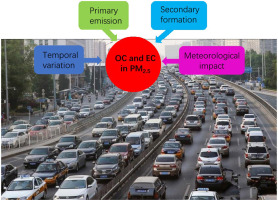当前位置:
X-MOL 学术
›
Atmos. Environ.
›
论文详情
Our official English website, www.x-mol.net, welcomes your feedback! (Note: you will need to create a separate account there.)
Online measurement of carbonaceous aerosols in suburban Shanghai during winter over a three-year period: Temporal variations, meteorological effects, and sources
Atmospheric Environment ( IF 5 ) Pub Date : 2020-04-01 , DOI: 10.1016/j.atmosenv.2020.117408 Lan Yao , Juntao Huo , Dongfang Wang , Qingyan Fu , Wenwen Sun , Qing Li , Jianmin Chen
Atmospheric Environment ( IF 5 ) Pub Date : 2020-04-01 , DOI: 10.1016/j.atmosenv.2020.117408 Lan Yao , Juntao Huo , Dongfang Wang , Qingyan Fu , Wenwen Sun , Qing Li , Jianmin Chen

|
Abstract Carbonaceous aerosols have adverse effects on both human health and the climate. To understand the temporal variations and sources of carbonaceous aerosols, organic carbon (OC) and elemental carbon (EC) were measured hourly in suburban Shanghai in 2015–2017 during winter. The average OC concentrations were 7.34 ± 4.51 μgC/m3 in 2015, 7.16 ± 4.43 μgC/m3 in 2016, and 6.4 ± 3.22 μgC/m3 in 2017. The EC concentrations decreased significantly each year, with average concentrations of 3.82 ± 2.43, 2.91 ± 2.28, and 2.46 ± 1.88 μgC/m3, respectively, which caused the OC/EC ratio to increase from 2015 to 2017. Although the meteorological conditions differed each winter, there was a similar pattern of OC and EC diurnal variations, with concentrations peaking at 08:00 and 20:00, largely due to rush-hour vehicle emissions. A downward trend of EC/CO and EC/NO2 (mass ratios) but steady CO and NO2 concentrations from 2015 to 2017 revealed that the characteristics of primary vehicle emissions changed, and that less EC was emitted. Secondary organic carbon (SOC) and primary organic carbon (POC) were estimated with the minimum R2 (MRS) method. The hiemal SOC/OC values in suburban Shanghai were 19.2 ± 18.6% in 2015, 31.1 ± 18.6% in 2016, and 51.0 ± 21.4% in 2017, exhibiting an increasing trend. As the PM2.5 concentration increased (from 0 to 50 μg/m3 to 100–300 μg/m3), a decreasing SOC/OC ratio (from 43.6 ± 23.9% to 21.8 ± 17.7%) was observed over the three years, showing that primary emissions were the main contributors to carbonaceous aerosols on haze days. Case analysis of haze events further demonstrated that the primary sources of OC and EC were vehicle emissions. The contributions of biomass burning and coal combustion to carbonaceous aerosols became less important over the study period. This study highlights the importance of controlling vehicle emissions to reduce carbonaceous aerosol concentrations in the suburbs of the Chinese megacity, Shanghai.
更新日期:2020-04-01



























 京公网安备 11010802027423号
京公网安备 11010802027423号